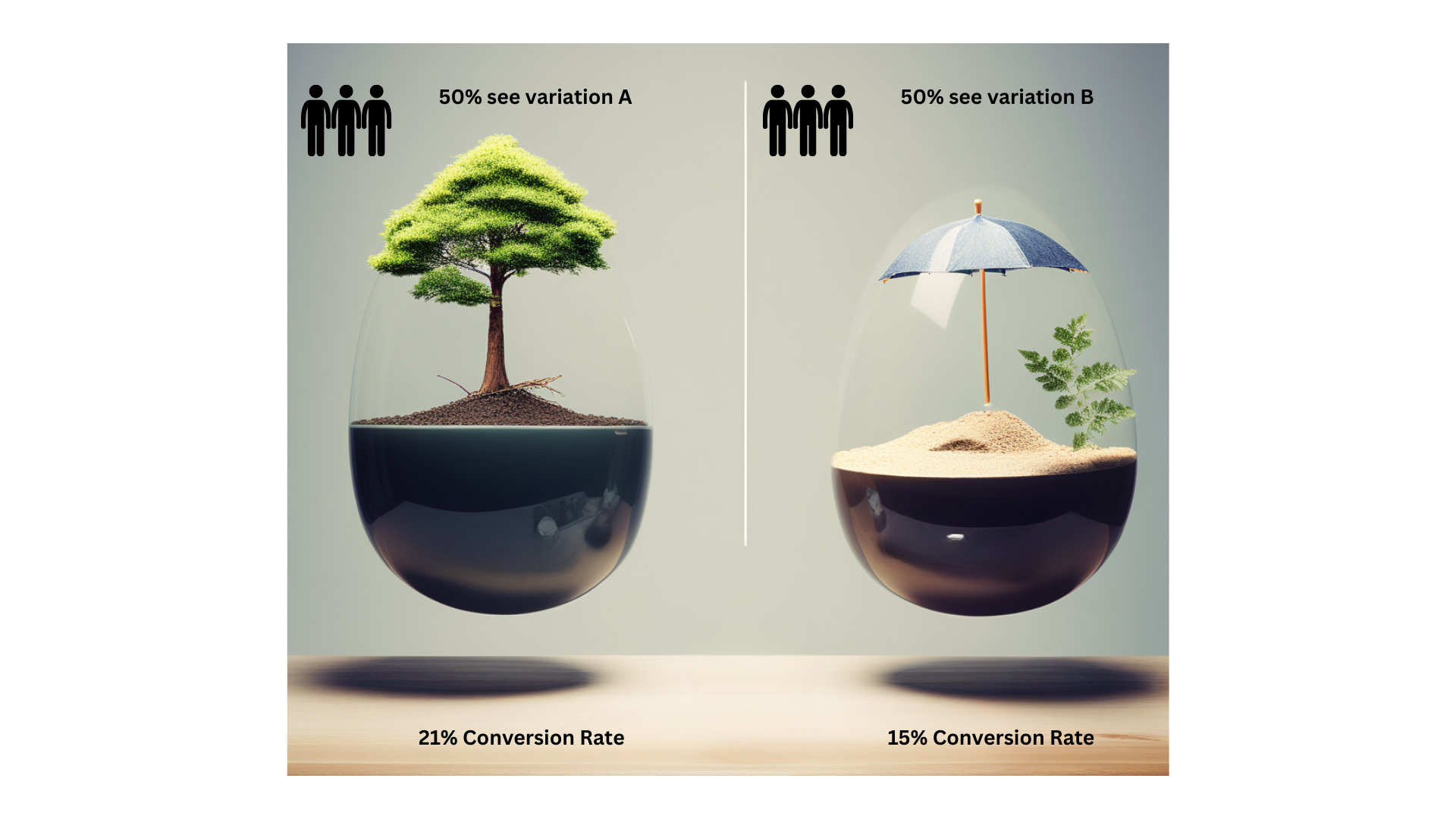The Power of A/B Testing in Your Marketing Strategy
In the world of digital marketing, staying ahead of the curve is essential to thrive in today’s competitive landscape. One of the most powerful tools at your disposal is A/B testing, a method that allows you to experiment with different variations of your marketing assets to determine which performs better. From email subject lines to website designs, A/B testing empowers you to make data-driven decisions that can significantly impact your bottom line.
What is A/B Testing?
A/B testing, also known as split testing, is a controlled experiment where two or more variants of a marketing asset are compared to determine which one yields better results. These assets can include anything from ad copies and landing pages to email layouts and call-to-action buttons. By randomly presenting different versions to your audience and measuring their responses, you can identify which variant drives higher engagement, conversions, or other key performance indicators (KPIs).

Why is A/B Testing Important?
Optimizing Conversion Rates:
A/B testing allows you to fine-tune your marketing materials to maximize conversion rates. By understanding what resonates best with your audience, you can tailor your messaging and design to encourage desired actions, whether it’s making a purchase, signing up for a newsletter, or downloading an app.
Enhancing User Experience:
With A/B testing, you can iterate on your website or app interface to create a smoother and more intuitive user experience. By analyzing user behavior and feedback, you can identify pain points and address them effectively, leading to higher customer satisfaction and retention.
Increasing ROI:
By identifying and implementing high-performing variations, A/B testing can ultimately lead to a higher return on investment (ROI) for your marketing campaigns. Instead of relying on guesswork or intuition, you can leverage concrete data to allocate your resources more efficiently and achieve better results with less expenditure.
Mitigating Risk:
A/B testing allows you to mitigate the risk of making significant changes to your marketing strategy. Rather than implementing sweeping alterations based on assumptions, you can test hypotheses on a smaller scale and gradually roll out changes that have been proven effective through experimentation.
How to Conduct A/B Testing?
Define Your Objectives:
Clearly outline the goals you aim to achieve through A/B testing. Whether it’s improving click-through rates, reducing bounce rates, or increasing purchases, having specific objectives will guide your experimentation process.
Identify Variables:
Determine which elements of your marketing asset you want to test. This could include headline variations, imagery, color schemes, button text, or even the layout of a webpage. Focus on one variable at a time to ensure clear and actionable results.
Create Variations:
Develop multiple versions of your marketing asset, each featuring a different variation of the variable you’re testing. Ensure that each variant is distinct enough to produce meaningful differences in user behavior.

Randomize and Test:
Randomly assign visitors to your website or recipients of your marketing emails to different variants, ensuring that each variant receives a comparable amount of traffic or impressions. Monitor relevant metrics, such as conversion rates or engagement levels, to determine which variant performs best.
Statistical Analysis:
Use statistical methods to analyze the results of your A/B test and determine whether the observed differences in performance are statistically significant. This will help you draw reliable conclusions and avoid making decisions based on random fluctuations in data.
Implement Changes:
Once you’ve identified a winning variation, implement it across your marketing channels to capitalize on its success. Continuously monitor performance metrics to ensure that the improvements are sustained over time.
Type Of A/B Testing :
Standard A/B Testing: This is the most basic form of A/B testing where two versions (A and B) of a webpage or digital asset are compared to see which one performs better based on a predefined metric, such as click-through rate, conversion rate, or bounce rate.
Multivariate Testing: In multivariate testing, multiple elements on a webpage or digital asset are tested simultaneously to determine the best combination. Instead of testing two completely different versions (as in standard A/B testing), different variations of various elements (such as headlines, images, call-to-action buttons) are tested to see which combination yields the best results.
Split URL Testing: In split URL testing, users are directed to different URLs representing different versions of a webpage or digital asset. This method is useful when testing significant changes that cannot be easily implemented through simple HTML or JavaScript modifications.
A/B/C Testing: This type of testing involves comparing three variations (A, B, and C) instead of just two. It allows for more complex comparisons and can be useful for testing multiple variations of a design or content.
Sequential A/B Testing: Sequential A/B testing involves testing multiple versions sequentially rather than simultaneously. In this approach, the winning version from each test becomes the control for the next test, allowing for iterative improvements over time.
Platform-specific Testing: Some platforms and tools offer specialized forms of A/B testing tailored to their specific capabilities and requirements. For example, email marketing platforms may offer A/B testing features specifically for testing subject lines, sender names, or email content.
Bandit Testing: Bandit testing is a more advanced form of A/B testing that dynamically allocates traffic to different variations based on their performance. This method is particularly useful in situations where traffic or user behavior may vary over time.
Each type of A/B testing has its own advantages and limitations, and the choice of which type to use depends on factors such as the goals of the test, the resources available, and the level of complexity required.
Example :
The company wants to increase the open rate of their promotional emails, which currently stands at 20%. They decide to conduct an A/B test to determine which subject line generates higher engagement.
A/B Test:
A: “Get Fit Today! 20% Off All Gym Equipment”
B: “Transform Your Workout Routine with Our Exclusive Offer”
Both subject lines aim to convey a sense of urgency and highlight the discount, but they differ in tone and specificity.
After sending out 10,000 emails with subject line A to one segment of their email list and 10,000 emails with subject line B to another segment, they analyze the results:
Subject Line A: Open Rate – 22%
Subject Line B: Open Rate – 25%
In this example, subject line B outperformed subject line A by 3%. Based on these results, the company concludes that the more personalized and aspirational language of subject line B resonated better with their audience, leading to a higher open rate.
- The company decides to implement subject line B in future email campaigns to capitalize on its higher engagement rate.
- They also apply the insights gained from this test to refine other elements of their marketing strategy, such as ad copy and social media content, to maintain consistency in messaging across channels.
- Additionally, they continue to conduct A/B tests on other aspects of their email marketing, such as email content, CTAs, and sending times, to further optimize performance and drive conversions.
By using A/B testing to compare different subject lines, the e-commerce company was able to improve the effectiveness of their email marketing campaign and ultimately increase engagement with their target audience.
Conclusion:
In conclusion, A/B testing is a valuable tool that empowers marketers to optimize their strategies, enhance user experiences, and maximize ROI. By systematically experimenting with different variations and analyzing the results, you can gain valuable insights into what resonates best with your audience and drive continuous improvement in your marketing efforts. Incorporating A/B testing into your toolkit can give you a competitive edge in today’s dynamic digital landscape, helping you stay agile and responsive to the evolving needs and preferences of your target audience.
By incorporating A/B testing into your marketing strategy, you can unlock new opportunities for growth and success while mitigating the risks associated with uncertainty and guesswork. Embrace the power of experimentation and data-driven decision-making to propel your marketing efforts to new heights.



